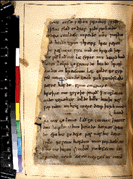The Old English Poetry Room
Welcome to the Old English Poetry Room. This room is dedicated to a bit of history from the Old English Period and the poetry studied in this course. A visit to the connecting room regarding the Sutton Hoo is recommended.
The Anglo-Saxon Chronicles
The Anglo-Saxon Chronicles were written by a number of unknown monks and covered events starting with pre-Roman Britain. The Chronicles are seven manuscripts and two fragments. They were compiled sometime in the last decade of the ninth century. Since there were few sources of history open to the monks, it is speculated that they relied heavily on Bede's An Ecclesiastical History of the English People for information on the period between the Roman occupation and 731.
From the first century to sometime in the fifth century, Britain was a colony of the Roman Empire. Settlers came and built villas, baths, libraries and city walls in the Roman tradition. Many of these survived. The ruins were sometimes referred to as the "work of giants" in early literature. This can be seen in The Wanderer, a poem about a man who has lost his lord and is stoicly wandering about lamenting his loss and looking for a new home.
From about 350 A.D., Roman power weakened throughout the empire. After 409, the Romans no longer ruled Britain. Then, in 449, the Anglo-Saxon invasions began. According to The Anglo-Saxon Chronicles , the first group of immigrants most likely came from Germany and the Netherlands. Their leaders were supposedly Hengest and Horsa. It is possible that these are legendary leaders, but it also possible that the Hengest who appears in the epic poem Beowulf is the same individual.
The Chronicles mention three main groups during the period of the invasions: the Saxons, the Angles and the Jutes. In the sixth century, the Anglo-Saxon advance was halted and 50 years of peace followed.
The Venerable Bede (c. 673 - 735) is one of three Christian figures mentioned in The Chronicles. Bede studied and wrote on many subjects, among them classical languages, astronomy and medicine. His An Ecclesiastical History of the English People covers England's history and conversion to Christianity. The first writers of The Chronicles used his year-by-year approach and took much of their information from this work. If you would like to access another website with more information about the Venerable Bede, click here.
It is from Bede's An Ecclesiastical History of the English People that we studied Caedmon's Hymn, a poem about a man who lives to a rather advanced age without ever learning any songs. At feasts, when the harp is passed around for the telling of stories, Caedmon would rather leave the feast than receive the harp to tell a story. One evening, he leaves the feast and is visited by an angel who asks him to "sing me something." He replies, "I don't know how to sing; that is why I left the feast to come here--because I cannot sing." (Norton, 17) He is told to sing about the Creation. From that point forward, he is able to hear religious stories, learn them by just listening, and create the incredible religious songs. To visit another website and read the verse that Caedmon sings, click here.
(from The Anglo-Saxon Chronicles and The Norton Anthology of English Literature)
Beowulf
In the sixteenth century, Henry VII confiscated the libraries of many monasteries. The Beowulf manuscript survived this event as well as a fire at the library of Sir Robert Bruce Cotton in 1731. It was charred in that fire and it continues to deteriorate more as time passes. Dane Thorkelin made copies of the Beowulf manuscript in 1787, but these also burned in a fire which occurred during the British bombardment of Copenhagen in 1807. Some of Thorkelin's copies did survive. It is through these copies that some words, which have otherwise disappeared from the original manuscript, have been preserved .
Beowulf, like other old English poetry, is a lyrical poem. This particular type of verse was typically sung out loud accompanied by a harp. It uses a "system of versification" and rarely uses end rhyme. Most lines have four beats with a pause in the middle. The sound at the beginning of the third beat or "lift also appears at (i.e., alliterate with) the beginning of the first lift, or of the second lift, or of both of them, but never at the beginning of the fourth lift." (Hieatt, 5)
(from Beowulf and Other Old English Poems)

To go to a website called "The Electronic Beowulf Project" click on the image at left. This site gives a background on the project to produce digital images of the Beowulf manuscript as well as other related manuscripts.
Trivia Corner
A Bit of Trivia about mead, a drink which appears throughout Beowulf (from An Incomplete Education):
Mead is a sweet, fermented honey wine which can be dated as far back as 2,000 B.C. when the Babylonians were known to drink it. Mead was declared the official wedding drink and the tradition stated that the bride's parents had to supply the groom with the "wine of the bee" for one whole month after the marriage. That month became known as the honeymonth and later became our honeymoon.
To continue your tour, click on one of the rooms below:
